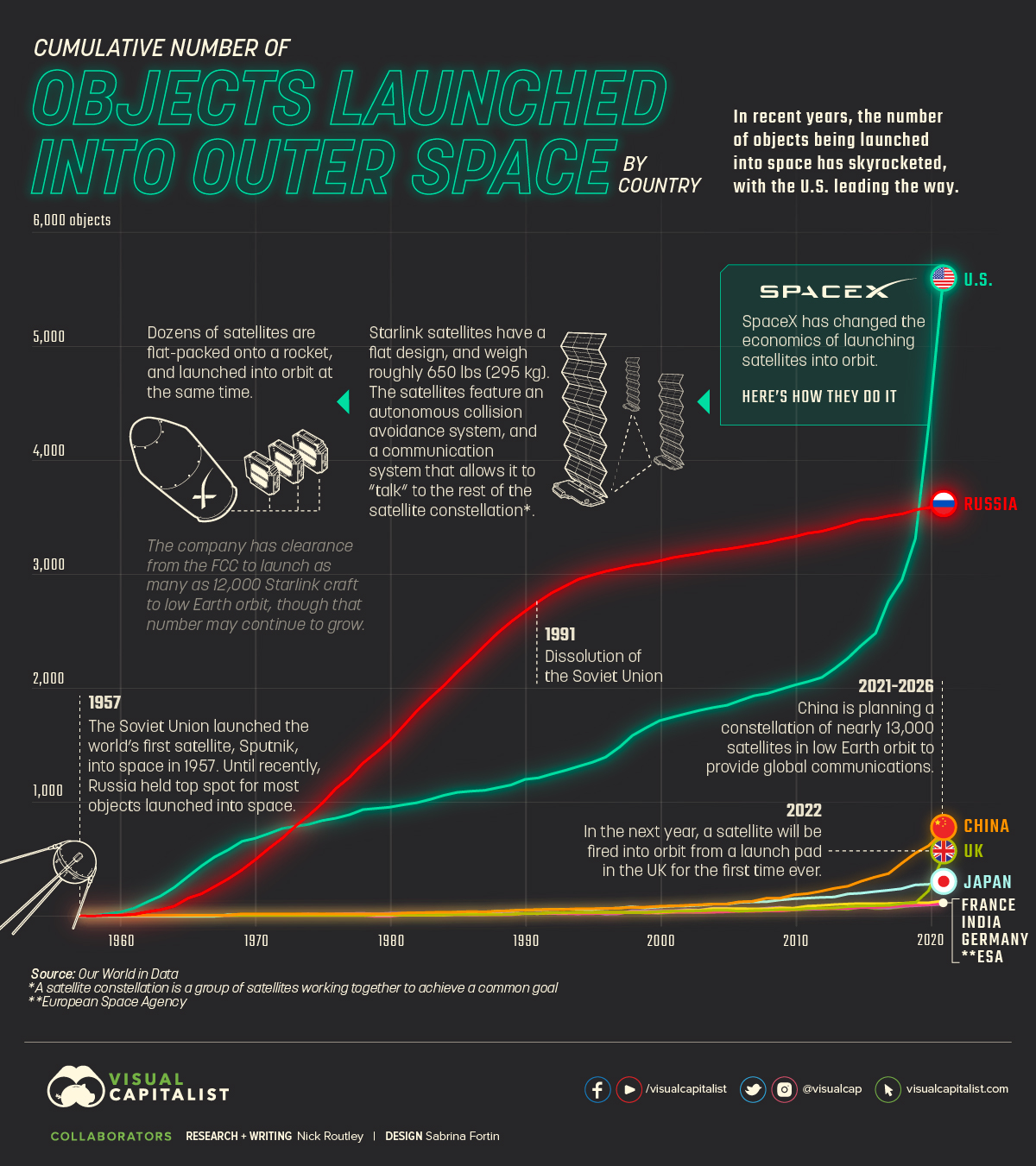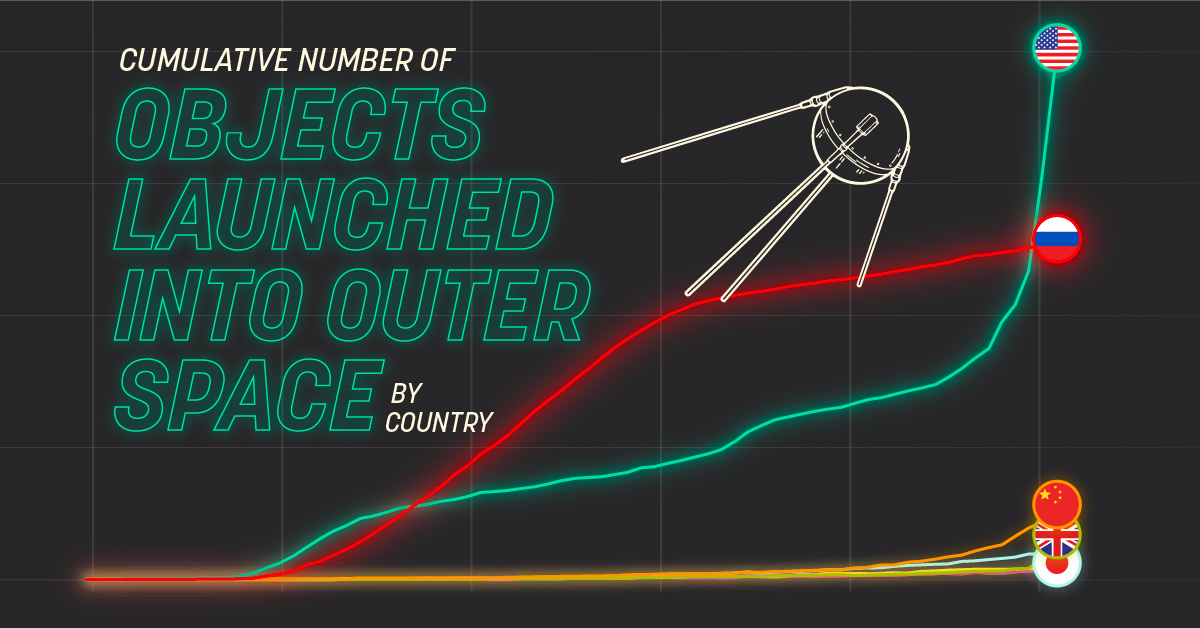Misc
Visualized: Which Countries are Dominating Space?

Visualized: Which Countries are Dominating Space
Believe it or not, there is a lot of stuff in space. In fact, our atmosphere is filled with more than 11,000 objects that have been launched since the foray into space began.
The Space Race started during the Cold War, and early on the Soviet Union dominated when it came to the amount of devices and objects launched into our atmosphere. But a few years ago, the U.S. took back that title with Elon Musk’s SpaceX helping lead the charge.
This visual, using data from Our World in Data, breaks down the amount of objects launched into space by country over time.
What Gets Launched Into Space?
What are the objects being sent into our atmosphere and why are they so important? Here’s a look at just a few:
- Satellites
- Crewed spacecraft
- Probes
- Space station flight equipment
Probes and landers like the Mars Rover, for example, have helped scientists explore other planets. Satellites provide us with everyday necessities like cell phone service, far reaching television signals, satellite imagery, and GPS.
As of late 2021, there were around 4,852 operational satellites in orbit—2,944 belonging to the United States. Here’s a quick look at what the U.S. uses its satellites for:
- Commercial: 2,516
- Military: 230
- Government: 168
- Civil: 30
Many satellites in orbit, however, are no longer functional. In fact, there is a lot of junk in space—according to NASA, there are over 27,000 pieces of space debris in orbit.
The Space Race, by Country
The venture into outer space began during the Cold War when the USSR launched the first satellite, Sputnik 1 in 1957. After this, the U.S. and Soviet Union entered a definitive competition between technological advancements and scientific exploration into space—an extension of the battle between political ideologies.
Few countries have come close in matching either the U.S. or Russia so far. Here’s a look at the cumulative number of objects different countries have launched into orbit and beyond.
| Rank | Country | Cumulative Number of Objects Launched into Space |
|---|---|---|
| #1 | 🇺🇸 United States | 5,534 |
| #2 | 🇷🇺 Russia | 3,611 |
| #3 | 🇨🇳 China | 731 |
| #4 | 🇬🇧 UK | 515 |
| #5 | 🇯🇵 Japan | 300 |
| #6 | 🇫🇷 France | 130 |
| #7 | 🇮🇳 India | 127 |
| #8 | 🇩🇪 Germany | 114 |
| #9 | 🇨🇦 Canada | 82 |
| #10 | 🇱🇺 Luxembourg | 53 |
| #11 | 🇮🇹 Italy | 52 |
| #12 | 🇰🇷 South Korea | 43 |
| #13 | 🇧🇷 Brazil | 39 |
| #14 | 🇦🇺 Australia | 36 |
| #15 | 🇧🇪 Belgium | 36 |
| #16 | 🇮🇱 Israel | 30 |
| #17 | 🇪🇸 Spain | 29 |
| #18 | 🇺🇾 Uruguay | 23 |
| #19 | 🇮🇩 Indonesia | 21 |
| #20 | 🇦🇷 Argentina | 20 |
| #21 | 🇸🇪 Sweden | 19 |
| #22 | 🇲🇽 Mexico | 18 |
| #23 | 🇸🇦 Saudi Arabia | 17 |
| #24 | 🇦🇪 United Arab Emirates | 17 |
| #25 | 🇹🇼 Taiwan | 17 |
| #26 | 🇫🇮 Finland | 17 |
| #27 | 🇹🇷 Turkey | 16 |
| #28 | 🇨🇭 Switzerland | 15 |
| #29 | 🇹🇭 Thailand | 14 |
| #30 | 🇳🇿 New Zealand | 14 |
| #31 | 🇳🇴 Norway | 14 |
| #32 | 🇳🇱 Netherlands | 13 |
| #33 | 🇩🇰 Denmark | 12 |
| #34 | 🇪🇬 Egypt | 9 |
| #35 | 🇰🇿 Kazakhstan | 9 |
| #36 | 🇲🇾 Malaysia | 9 |
| #37 | 🇱🇹 Lithuania | 9 |
| #38 | 🇺🇦 Ukraine | 8 |
| #39 | 🇵🇱 Poland | 8 |
| #40 | 🇻🇳 Vietnam | 7 |
| #41 | 🇵🇭 Philippines | 7 |
| #42 | 🇨🇿 Czechia | 7 |
| #43 | 🇩🇿 Algeria | 6 |
| #44 | 🇮🇷 Iran | 6 |
| #45 | 🇵🇰 Pakistan | 6 |
| #46 | 🇳🇬 Nigeria | 5 |
| #47 | 🇿🇦 South Africa | 5 |
| #48 | 🇭🇺 Hungary | 5 |
| #49 | 🇻🇪 Venezuela | 4 |
| #50 | 🇵🇪 Peru | 4 |
| #51 | 🇨🇱 Chile | 4 |
| #52 | 🇲🇦 Morocco | 3 |
| #53 | 🇦🇿 Azerbaijan | 3 |
| #54 | 🇬🇷 Greece | 3 |
| #55 | 🇪🇪 Estonia | 3 |
| #56 | 🇧🇾 Belarus | 3 |
| #57 | 🇧🇬 Bulgaria | 3 |
| #58 | 🇦🇹 Austria | 3 |
| #59 | 🇨🇴 Colombia | 2 |
| #60 | 🇪🇨 Ecuador | 2 |
| #61 | 🇰🇵 North Korea | 2 |
| #62 | 🇧🇩 Bangladesh | 2 |
| #63 | 🇵🇬 Papua New Guinea | 2 |
| #64 | 🇸🇰 Slovakia | 2 |
| #65 | 🇸🇮 Slovenia | 2 |
| #66 | 🇬🇭 Ghana | 1 |
| #67 | 🇪🇹 Ethiopia | 1 |
| #68 | 🇰🇪 Kenya | 1 |
| #69 | 🇷🇼 Rwanda | 1 |
| #70 | 🇦🇴 Angola | 1 |
| #71 | 🇬🇹 Guatemala | 1 |
| #72 | 🇨🇷 Costa Rica | 1 |
| #73 | 🇧🇴 Bolivia | 1 |
| #74 | 🇵🇾 Paraguay | 1 |
| #75 | 🇲🇳 Mongolia | 1 |
| #76 | 🇹🇲 Turkmenistan | 1 |
| #77 | 🇯🇴 Jordan | 1 |
| #78 | 🇶🇦 Qatar | 1 |
| #79 | 🇱🇰 Sri Lanka | 1 |
| #80 | 🇳🇵 Nepal | 1 |
| #81 | 🇧🇹 Bhutan | 1 |
| #82 | 🇱🇦 Laos | 1 |
| #83 | 🇱🇻 Latvia | 1 |
| #84 | 🇷🇴 Romania | 1 |
| #85 | 🇲🇨 Monaco | 1 |
| #86 | 🇵🇹 Portugal | 1 |
One important disclaimer here is that not all of these countries have orbital launch capabilities, meaning that although the satellite in space may belong to a certain country, that doesn’t mean that it was launched by said country. For example, the UK’s first launch in 1971 was out of Australia and France’s first launch took place in Algeria in 1965.
In total, around 86 countries have attempted some kind of entry into space. However, as of 2022, only 11 countries have the ability to send objects into space using their own launch vehicles, and only three—the U.S., Russia, and China—have ever launched people into outer space.
The Future of Space
With corporations beginning to take the lead in this new frontier, the landscape of space launches is changing. In 2019 Starlink, a constellation of satellites which provides 36 countries with internet access, was launched. With over 2,200 Starlink satellites in the sky and counting, SpaceX’s ultimate goal is global internet coverage; China is planning a similar venture.
Beyond useful satellites and scientific exploration, other potential space industries are emerging.
As one example, the business of commercial space tourism is no longer a futuristic concept. In late 2021, famous billionaire and founder of Virgin Galactic, Richard Branson flew briefly into space on a private flight. Jeff Bezos, having founded Blue Origin, followed shortly after.
Today, both Blue Origin and Virgin Galactic are licensed by the Federal Aviation Administration for passenger space travel. However, if you want to be launched into space, it will cost you around $250,000-$500,000.
Maps
Mapped: The 10 U.S. States With the Lowest Real GDP Growth
In this graphic, we show where real GDP lagged the most across America in 2023 as high interest rates weighed on state economies.

The Top 10 U.S. States, by Lowest Real GDP Growth
This was originally posted on our Voronoi app. Download the app for free on iOS or Android and discover incredible data-driven charts from a variety of trusted sources.
While the U.S. economy defied expectations in 2023, posting 2.5% in real GDP growth, several states lagged behind.
Last year, oil-producing states led the pack in terms of real GDP growth across America, while the lowest growth was seen in states that were more sensitive to the impact of high interest rates, particularly due to slowdowns in the manufacturing and finance sectors.
This graphic shows the 10 states with the least robust real GDP growth in 2023, based on data from the Bureau of Economic Analysis.
Weakest State Economies in 2023
Below, we show the states with the slowest economic activity in inflation-adjusted terms, using chained 2017 dollars:
| Rank | State | Real GDP Growth 2023 YoY | Real GDP 2023 |
|---|---|---|---|
| 1 | Delaware | -1.2% | $74B |
| 2 | Wisconsin | +0.2% | $337B |
| 3 | New York | +0.7% | $1.8T |
| 4 | Missississippi | +0.7% | $115B |
| 5 | Georgia | +0.8% | $661B |
| 6 | Minnesota | +1.2% | $384B |
| 7 | New Hampshire | +1.2% | $91B |
| 8 | Ohio | +1.2% | $698B |
| 9 | Iowa | +1.3% | $200B |
| 10 | Illinois | +1.3% | $876B |
| U.S. | +2.5% | $22.4T |
Delaware witnessed the slowest growth in the country, with real GDP growth of -1.2% over the year as a sluggish finance and insurance sector dampened the state’s economy.
Like Delaware, the Midwestern state of Wisconsin also experienced declines across the finance and insurance sector, in addition to steep drops in the agriculture and manufacturing industries.
America’s third-biggest economy, New York, grew just 0.7% in 2023, falling far below the U.S. average. High interest rates took a toll on key sectors, with notable slowdowns in the construction and manufacturing sectors. In addition, falling home prices and a weaker job market contributed to slower economic growth.
Meanwhile, Georgia experienced the fifth-lowest real GDP growth rate. In March 2024, Rivian paused plans to build a $5 billion EV factory in Georgia, which was set to be one of the biggest economic development initiatives in the state in history.
These delays are likely to exacerbate setbacks for the state, however, both Kia and Hyundai have made significant investments in the EV industry, which could help boost Georgia’s manufacturing sector looking ahead.
-

 Technology1 week ago
Technology1 week agoCountries With the Highest Rates of Crypto Ownership
-

 Mining6 days ago
Mining6 days agoVisualizing Copper Production by Country in 2023
-

 Politics7 days ago
Politics7 days agoCharted: How Americans Feel About Federal Government Agencies
-

 Healthcare1 week ago
Healthcare1 week agoWhich Countries Have the Highest Infant Mortality Rates?
-

 Demographics1 week ago
Demographics1 week agoMapped: U.S. Immigrants by Region
-

 Economy1 week ago
Economy1 week agoMapped: Southeast Asia’s GDP Per Capita, by Country
-

 Automotive1 week ago
Automotive1 week agoHow People Get Around in America, Europe, and Asia
-

 Personal Finance1 week ago
Personal Finance1 week agoVisualizing the Tax Burden of Every U.S. State


















